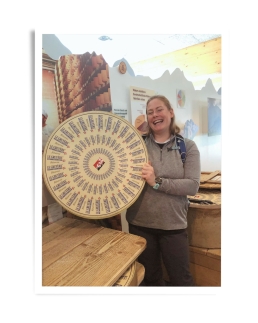
Have you ever wondered how cheese is made?
As a big cheese fan, I decided to investigate by visiting the Gruyère cheese dairy in Switzerland.
Gruyère (pronounced groo-yair) is made in the town of Gruyères and like most Swiss towns and villages, it’s picture perfect with lush, green, rolling hills, the sound of cow bells in the nearby fields and mountains.
Grue is actually the French word for a crane and the bird is the emblem of the town, featuring on flags or as ornaments in people’s gardens.
As I write this, Gruyère has just been named the best cheese in the world for the second year in a row at the World Cheese Awards, which was hosted in Newport, Wales, beating nearly 4000 other cheeses. Who else wishes they were on the judging panel for this?!
Gruyère is found in all the supermarkets in the UK. So, if by the end of reading this your mouth is watering, then you don’t have to come all the way to Switzerland to taste it!
This cheese dairy, (‘la fromagerie’ in French and ‘die Käserei’ in German), has been making cheese since 1115 with milk produced from cows within a 12-mile radius.
They offer a self-guided tour with an audio headset in multiple languages, have a restaurant where you can sample the cheese as part of many delicious regional and traditional dishes, along with a well-stocked gift shop, and twice a day you can watch the filling of the cheese moulds which is an important part of production.
Now to the numbers! To make a 35kg cheese wheel requires 400l of milk. A cow (‘une vache’ in French, ‘eine Kuh’ in German) has four stomachs and produces 25l of milk a day.
The Gruyère dairy produces 48 cheese wheels a day and exports them globally.
The cheese (‘le fromage’ in French, ‘der Käse‘ in German), is a hard cheese made from cow’s milk, just like British cheddar, but Gruyère has a more distinctive smell and taste (nutty and creamy) thanks to the grassy pastures the cows graze in.
Again, like British cheddar, there are numerous types of Gruyère which have been aged for different amounts of time. The longer they have been sat on the shelves, the more intense the flavour.
In the gift shop you can try and buy the different aged cheeses which range from five months/mild (‘doux’ in French, ‘mild’ in German), all the way up to 24 months/extra mature (‘vieux’ in French, ‘rezent’ in German).
I enjoyed my visit so much that I went back the following weekend when my friend came over to visit!
This time I listened to the tour in German, and I could buy some more cheese as I’d already eaten all the cheese from my visit the weekend before!
After visiting the alpine festival in Lenk im Simmental (see my previous blog) and the Gruyère cheese dairy, I feel like I now fully understand why the Swiss are so passionate about their cows as they produce the best cheese in the world!

Important words:
- distinctive – individual
- sample – taste
- well-stocked – filled with lots of something
- export – send to another country to sell
- pastures – grassland
- intense – greater/stronger

